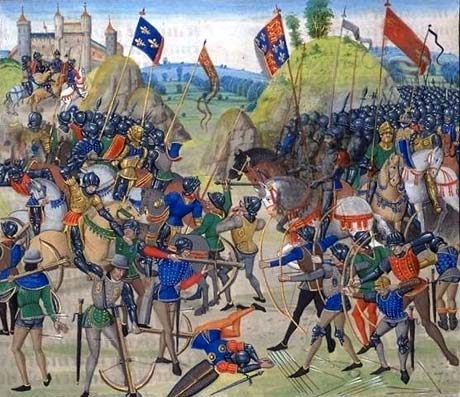| Author |
Message |
|
Chris Tandy
|
 Posted: Thu 02 Dec, 2010 6:32 am Post subject: Knee cops Posted: Thu 02 Dec, 2010 6:32 am Post subject: Knee cops |
 |
|
How are knee-cops (14th/15th century as worn by crossbowmen and the like) held firmly in place, assuming no other armour is worn?
I have acquired a pleasantly simple pair with one strap going around behind each knee, but short of tightening them like a tourniquet and not moving, the cops will not remain in place. Is there a historical precedent for having long ties up to the skirts of the arming-doublet?
|
|
   |
 |
|
Jens Boerner
Location: Erlangen, Germany Joined: 10 Jan 2008
Posts: 62
|
 Posted: Thu 02 Dec, 2010 7:26 am Post subject: Posted: Thu 02 Dec, 2010 7:26 am Post subject: |
 |
|
Well, quite simply: they were not worn without something in addtion 
In the 14th century leg armour would had been worn hardly in foot combat by not heavily armoured troups (examples see the wisby mass grave and the injuries taken there), and if, you would wear at least greaves, textile armour cuisses and kniee cops over that. In fact, I know of no source this was worn without maille chausses underneath (which would, after all, also make not much sense; those who had the money for greaves would first get their hands on maille chausses).
The only examples I know for knee armour worn seperatly is from the 15th century, for example the housebook from wolfegg, about 1475-80. But there the knee cops also are articulated, not simpy covering the knee.
Unfortunatly, one cannot tell how they were attached apart from straps arround the leg.
|
|
    |
 |
Michal Plezia
Industry Professional

|
 Posted: Thu 02 Dec, 2010 10:23 am Post subject: Posted: Thu 02 Dec, 2010 10:23 am Post subject: |
 |
|
Maybe they were attached with strings like gothic couters? http://www.myArmoury.com/images/features/pic_...gothic.gif
Jens could you give a link to the picture you mentioned? I can't find it anywhere.
www.elchon.com
Polish Guild of Knifemakers
The sword is a weapon for killing, the art of the sword is the art of killing. No matter what fancy words you use or what titles you put to
it that is the only truth.
|
|
   |
 |
|
Chris Kelson
|
 Posted: Fri 03 Dec, 2010 5:10 am Post subject: Posted: Fri 03 Dec, 2010 5:10 am Post subject: |
 |
|
I think he means like the ones depicted on the archers here and in other images in the chronicles of Froissart.
 Attachment: 50.41 KB Attachment: 50.41 KB

 Attachment: 41.07 KB Attachment: 41.07 KB

The best close up image I had.
|
|
  |
 |
|
Chris Tandy
|
 Posted: Fri 03 Dec, 2010 5:35 am Post subject: Knee cops. Posted: Fri 03 Dec, 2010 5:35 am Post subject: Knee cops. |
 |
|
The very cops that I was considering! I guessed Froissart would show these. Many thanks for illustration.
I accept the possibility that if they were more poleyn than cop, there is better scope for extra strapping around the leg. But one knee-piece (plus fan or rose) to the outside does not really allow for this.
Were they laced directly to hose? It does not sound very satisfactory!
|
|
   |
 |
Bram van Diemen

Location: Tilburg Joined: 26 Oct 2010
Posts: 29
|
 Posted: Fri 03 Dec, 2010 7:04 am Post subject: Posted: Fri 03 Dec, 2010 7:04 am Post subject: |
 |
|
|
I had something like that. Only it kept sliding down my legs. I wander how they done it without restricting the bloodflow to your feet.
|
|
  |
 |
|
Jens Boerner
Location: Erlangen, Germany Joined: 10 Jan 2008
Posts: 62
|
 Posted: Fri 03 Dec, 2010 7:18 am Post subject: Posted: Fri 03 Dec, 2010 7:18 am Post subject: |
 |
|
http://upload.wikimedia.org/wikipedia/commons...eerzug.jpg right in the middle.
I have no idea how they were attached. I also resume lacing to the hose. For leg armour in general we also actually do not know how it was attached. As far as I know there is no clear evidence for it being attached to the doublet, like many people solve that. In the 13th and 14th century, the leg armour was attached to something called "lendenier", described as a kind of belt, sometimes quilted and laced ("hart gespannet", limburg chronicles).
|
|
    |
 |
Chuck Russell

|
 Posted: Fri 03 Dec, 2010 12:18 pm Post subject: Posted: Fri 03 Dec, 2010 12:18 pm Post subject: |
 |
|


we just point them to the hosen
|
|
    |
 |
|
Lafayette C Curtis
|
 Posted: Tue 07 Dec, 2010 9:11 am Post subject: Posted: Tue 07 Dec, 2010 9:11 am Post subject: |
 |
|
|
I also wear steel knee cops/poleyns, sometimes even with civilian gear, and the most practical method of all the ones I've tried so far is pointing the piece to the hose beneath. Stuffing a small amount of padding inside the piece also helps quite a bit, but I'm not sure that this expedient has any historical basis.
|
|
  |
 |
Michal Plezia
Industry Professional

|
 Posted: Mon 27 Jun, 2011 4:39 am Post subject: Posted: Mon 27 Jun, 2011 4:39 am Post subject: |
 |
|
I have a question concerning cups, but this time elbow cups (couters) 
Is there any evidence for the articulated couters without rerebrace and vambrace, analogical to those knee cups you've presented?
www.elchon.com
Polish Guild of Knifemakers
The sword is a weapon for killing, the art of the sword is the art of killing. No matter what fancy words you use or what titles you put to
it that is the only truth.
|
|
   |
 |
|
|

